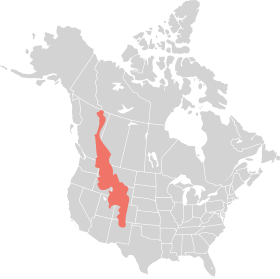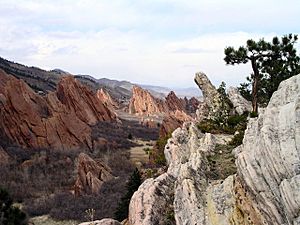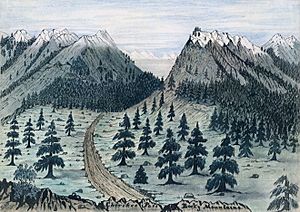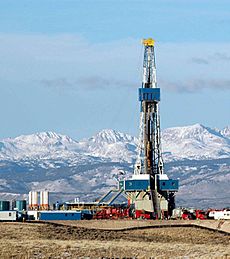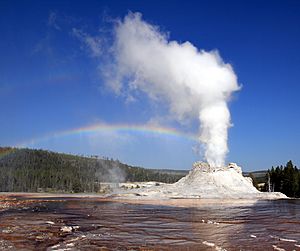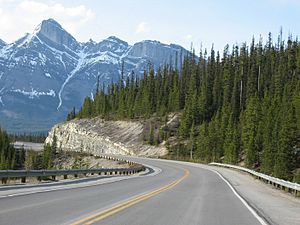Rocky Mountains facts for kids
Quick facts for kids Rocky Mountains |
|
|---|---|
| The Rockies (en), Les montagnes Rocheuses (fr), Montañas Rocosas, Rocallosas (es) | |
| Highest point | |
| Peak | Mount Elbert |
| Elevation | 14,440 feet (4401.2 m) |
| Dimensions | |
| Length | 4,828 km (3,000 mi) |
| Area | 777,000 km2 (300,000 sq mi) |
| Geography | |
| Countries |
|
| Range coordinates | 43°44′28″N 110°48′07″W / 43.741°N 110.802°W |
| Parent range | North American Cordillera |
| Geology | |
| Age of rock | Precambrian and Cretaceous |
| Type of rock | |
The Rocky Mountains, also called the Rockies, are a huge mountain range in North America. They stretch for about 3,000 miles (4,800 kilometers) (4,828 km). This long chain of mountains goes from northern Canada all the way to New Mexico in the United States. The Rockies are different from other mountain ranges like the Cascade Range and Sierra Nevada, which are newer and further west.
The Rockies started forming between 55 and 80 million years ago. This happened when large pieces of the Earth's crust, called plates, slowly slid under the North American plate. Over millions of years, glaciers and weather have shaped the Rockies into the amazing peaks and valleys we see today. After the last ice age, people began living in these mountains. Explorers like Sir Alexander Mackenzie and the Lewis and Clark Expedition helped map the area. People first came to the mountains for valuable resources like minerals and animal furs. Today, the Rockies are a popular place for tourists, especially for outdoor activities like hiking, skiing, and camping.
Most of the tallest peaks in the Rocky Mountains are in Colorado. This state has a high average elevation of over 2,000 metres (6,600 ft). Many parts of the mountains are protected as public parks and forests.
Contents
What's in a Name?
The name "Rocky Mountains" comes from an Algonquian language. Specifically, it's from the Cree word asin-wati, which means "rocky mountain." The first time a European wrote about them was in 1752. A French explorer named Jacques Legardeur de Saint-Pierre called them "montagnes de Roche," meaning "mountains of rock."
Where are the Rockies?
The Rocky Mountains are the easternmost part of the huge North American Cordillera. They are usually said to stretch from the Liard River in British Columbia south to the Pecos River in New Mexico. The Rockies can be from 110 to 480 kilometres (70 to 300 miles) wide.
The highest point in the entire range is Mount Elbert in Colorado. It stands at 4,401 metres (14,440 feet) above sea level. In the Canadian Rockies, the tallest peak is Mount Robson in British Columbia, at 3,954 m (12,972 ft).
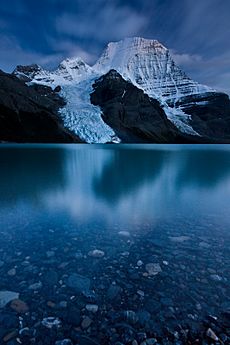
The eastern side of the Rockies rises sharply from the flat Interior Plains. This includes ranges like the Front Range in Colorado and the Wind River Range in Wyoming.
The Continental Divide of the Americas runs through the Rocky Mountains. This is a line where water on one side flows to the Atlantic Ocean and water on the other side flows to the Pacific Ocean. Triple Divide Peak in Glacier National Park is special. Water falling on it can flow to the Atlantic, Pacific, or even Hudson Bay!
Not many people live in the Rockies, with only about four people per square kilometer. However, the number of people living in the Rocky Mountain states has grown a lot since the 1950s.
How the Rockies Formed
The rocks that make up the Rocky Mountains are very old. The oldest rocks are from the Precambrian time, over a billion years ago. Later, western North America was covered by a shallow sea. This sea left behind many layers of limestone and dolomite.
About 300 million years ago, some mountains called the Ancestral Rocky Mountains formed. These mountains were made of old rocks pushed up through the sea layers. They wore away over time, leaving behind lots of sedimentary rock.
The current Rocky Mountains began to form between 80 and 55 million years ago. This was during an event called the Laramide orogeny. Imagine pushing a rug on a hard floor: the rug bunches up and forms wrinkles. In Canada, this is like the Earth's plates pushing the old rocks (the rug) against the strong Canadian Shield (the hard floor).
Further south in the U.S., a different process might have happened. A plate slid under North America at a very shallow angle. This low angle caused mountains to form much further inland than usual. Huge pushes of rock piled up, creating the wide, tall Rocky Mountain range.
After the mountains formed, erosion slowly wore them down. This process revealed the older rocks underneath and created the beautiful landscape we see today.
Glaciers also played a big role. During the ice ages, massive sheets of ice carved out U-shaped valleys and bowl-shaped hollows called cirques. These glaciers left their mark on the Rockies, shaping many of the dramatic features.
Animals and Plants
The Rocky Mountains have many different environments because they are so long and cover many different elevations. For example, the lowest areas have prairie grasses. The highest areas, above the tree line, have Alpine tundra, where no trees can grow. The tree line changes from about 3,700 m (12,000 ft) in New Mexico to 760 m (2,500 ft) in the far north.
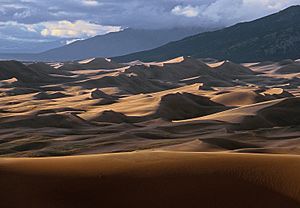
There are ten different forest zones in the Rockies. These zones depend on how warm, cold, wet, or dry an area is. For example, warmer areas might have pinyon pines, while colder, wetter areas have Douglas firs or spruce trees. Near the tree line, trees might be small and shrub-like due to harsh conditions.
The Rocky Mountains are home to many famous animals. These include wolves, elk, moose, mule and white-tailed deer, pronghorn, mountain goats, bighorn sheep, badgers, black bears, grizzly bears, coyotes, lynxes, cougars, and wolverines. The largest groups of elk in North America live in the foothills of Alberta and British Columbia.
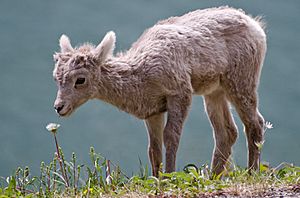
Sadly, some animal populations have decreased since European-Americans settled in the mountains. For example, bighorn sheep numbers have dropped. However, some apex predators like grizzly bears and wolf packs, which had disappeared from some areas, are now returning thanks to conservation efforts. Other animals like the bald eagle and peregrine falcon are also recovering.
History of the Rockies
Early People

For thousands of years, the Rocky Mountains have been home to many Native American tribes. These include the Apache, Arapaho, Blackfoot, Cheyenne, Crow Nation, Ute, and many others. Early people, called Paleo-Indians, hunted large animals like mammoths in the valleys. Later tribes likely moved between the plains in winter to hunt bison and the mountains in summer for fish, deer, and berries. Some rock walls built by Native Americans to help hunt game in Colorado are over 5,000 years old.
European Explorers Arrive
The history of the Rockies changed quickly when Europeans arrived. In 1540, the Spanish explorer Francisco Vázquez de Coronado came to the southern Rocky Mountain region. In 1610, the Spanish founded Santa Fe, a city at the foot of the Rockies. The arrival of horses, metal tools, guns, new diseases, and different cultures greatly changed Native American life. Many Native American populations suffered from diseases, wars, and the loss of their traditional ways of life.
In 1739, French fur traders Pierre and Paul Mallet were the first Europeans to report seeing the "Rockies."
Sir Alexander Mackenzie was the first European to cross the Rocky Mountains in 1793. He reached the Pacific coast of Canada, completing the first recorded journey across North America north of Mexico.
The Lewis and Clark Expedition (1804–1806) was the first scientific trip to the Rocky Mountains. They collected samples of plants, animals, and rocks. Their journey helped open the way for more European-Americans to explore the Rockies.
Fur traders, mostly French, Spanish, and British, explored the Rockies from 1720 to 1800 looking for minerals and furs. Trading posts like Rocky Mountain House were set up in Canada. These posts were bases for much of the early European activity in the Canadian Rockies.
Settling the Mountains
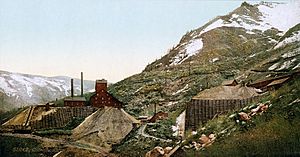
After 1802, fur traders and explorers brought the first large American presence to the southern Rockies. Famous figures like Jim Bridger and Kit Carson explored the area. In 1832, Benjamin Bonneville led the first wagon train across the Rockies using South Pass in Wyoming.
In Canada, fur trading posts were also set up west of the Northern Rockies. Over time, the United States and Britain settled their land claims in the region. In 1846, Britain gave up its claims south of the 49th parallel to the United States.
Thousands of people traveled through the Rockies on the Oregon Trail starting in the 1840s. The Mormons began settling near the Great Salt Lake in 1847. From 1859 to 1864, gold was found in Colorado, Idaho, Montana, and British Columbia. This led to several gold rushes, bringing many miners to the mountains. The Idaho gold rush alone produced more gold than the California and Alaska gold rushes combined.
The transcontinental railroad was finished in the U.S. in 1869. Yellowstone National Park became the world's first national park in 1872. In Canada, the Canadian Pacific Railway was completed in 1885. Canadian railway officials also helped create national parks like Jasper, Banff, and Yoho. These parks helped start a tourism industry that is still strong today. As towns grew, people also began to care about protecting the environment. U.S. President Benjamin Harrison created several forest reserves in the Rockies in the 1890s.
Rocky Mountain Economy
Industries and Resources
The Rocky Mountains have many valuable resources. Important minerals found here include copper, gold, lead, silver, and zinc. The Wyoming Basin and other areas have large amounts of coal, natural gas, and oil. For example, the Climax mine in Colorado was once the world's largest producer of molybdenum. This metal is used in strong steel for cars and planes.
However, many old mines have left behind toxic waste. For instance, zinc mining near the Eagle River in Colorado caused pollution. This harmed algae, moss, and fish. Cleaning up the river cost millions of dollars, but it helped the environment recover.
The Rockies also have a lot of coalbed methane, which is natural gas found in coal. This gas provides about 7 percent of the natural gas used in the U.S.
Farming and forestry are also big industries. Farmers grow crops and raise livestock. Animals are often moved between high mountain pastures in summer and lower areas in winter.
Tourism and Recreation
Millions of tourists visit the Rocky Mountains every year. Most people speak English, but some areas also have Spanish or Native American languages.
In summer, people come to hike, camp, and enjoy mountain sports. Popular places in the United States include:
- Yellowstone National Park
- Glacier National Park
- Grand Teton National Park
- Rocky Mountain National Park
- Great Sand Dunes National Park and Preserve
In Canada, the mountains have these national parks:
- Banff National Park
- Jasper National Park
- Kootenay National Park
- Waterton Lakes National Park
- Yoho National Park
Glacier National Park in Montana and Waterton Lakes National Park in Alberta are connected. They are known together as Waterton-Glacier International Peace Park.
In winter, skiing is a major attraction. There are many ski resorts throughout the Rockies.
The song Rocky Mountain High by John Denver was written in 1972. It is one of the official state songs of Colorado.
Staying Safe in the Rockies
When visiting the Rocky Mountains, it's important to be aware of safety. You might encounter bears or mountain lions. Other things to watch out for include bugs, wildfires, and very cold temperatures at night.
There have been accidents in the Rockies over the years, including falls from steep cliffs and falling rocks. It's important to be careful, especially in challenging terrain. Search and rescue teams are always ready to help if someone gets lost or hurt. The U.S. Forest Service does not keep public records of all accidents.
See also
 In Spanish: Montañas Rocosas para niños
In Spanish: Montañas Rocosas para niños


